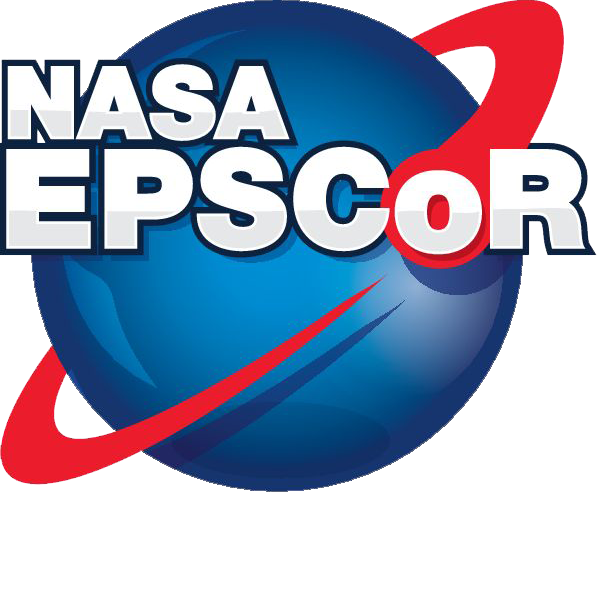
2017 NASA EPSCoR RID Projects
A Hybrid Structural Health Monitoring (SHM) System for Damage Detection of Structural Composites
Principal investigator: Dr. Mohammad Azarbayejani
Affiliation/Dept.: New Mexico Institute of Mining and Technology, Civil and Environmental Engineering Department
NASA Collaborator/NASA Center: Gregory F. Galbreath, Chief, Structures Branch/NASA Lyndon B. Johnson Space Center
Description: In recent years, advanced composite materials have been integrated extensively into aircraft structures. However, composite materials are very susceptible to hidden damage which makes it necessary to detect damage at its onset. To assess and monitor the performance of composite materials, an effective hybrid sensing system is proposed. The hybrid structural health monitoring (SHM) system is based on integrating piezoelectric (PZT) sensors and Fiber Bragg Grating (FBG) technology using guided lambwaves for damage detection in composites. The proposed system also has the advantage of being able to embed all the sensors in the fiber composites. The objectives of this proposal are: 1) To develop a test set-up including composite laminate, ultrasonic piezoelectric actuators and sensors/receivers, network analyzer, FBG sensors and FBG data interrogator. 2) To introduce damage due to impact load and also delamination in composite plate. 3) To develop the hybrid monitoring system to detect different levels of damage severity induced by impact and delamination. The network analyzer will actuate the guided lamb waves for the cases of healthy and damage plate and the waves will be sensed by PZT and FBG sensors. I am planning to hire UG engineering students at NMTech to become familiar with conducting academic research and publish in upcoming conferences. I believe the proposed research topic will contribute to establishing future research and innovative activities in New Mexico and is aligned with ARMD NASA strategic thrust 5. This project has the potential for follow-on funding from NASA, department of defense and NSF.
High Energy Density Metal Hybride Hydrogen Storage System for Space and Planetary Applications
Principal Investigator: Dr. Sarada Kuravi
Affiliation/Dept.: New Mexico State University, Mechanical and Aerospace Engineering
NASA Collaborator/NASA Center: Ratnakumar Bugga, Principal Member Technical Staff, Electrochemical Technologies Group/NASA Jet Propulsion Laboratory
Description: Hydrogen (H2) storage technologies can impact several space and planetary applications such as fuel cells, hydrogen balloons, in-situ resource utilization on Mars, sorption cryocoolers etc. Enabling high hydrogen storage density in a storage system is crucial for these applications to enable longer duration. Metal hydrides (MH) can enable storing of H2 at much lowers pressures compared to compressed hydrogen, however, efficient heat transfer is the key for these systems as the absorption and release of hydrogen is highly sensitive to system pressure and temperature. Primary issues in current heat transfer technologies used are added weight and reduced permeability effecting the storage density of the system.
Utilizing an external magnetic field to compress the MH powder and increase the contact/heat transfer area is proposed here to realize significant heat transfer with increased bed permeability. Preliminary calculations showed that the amount of hydrogen stored can be 37% higher compared to storage system with MH alone and 19% higher compared to storage system with MH and a heat transfer enhancement technique. Experiments are planned to test the porosity of the bed under varying magnetic fields. Results will be used to perform high fidelity numerical simulations and study the mass and heat diffusion characteristics in two MH storage systems. The outcomes of the project will help in designing high storage density H2 systems, which will help in substantial weight reduction of space systems. Four tasks covering the above work are planned for seven-month duration of the project. Key personnel include PI and two students.
Development of a Versatile Optical Technique for Far Range Strain Measurement
Principal Investigator: Dr. Eshan Niri
Affiliation/Dept.: New Mexico State University, Civil Engineering
NASA Collaborator/NASA Center: Cara Leckey, Senior Research Physicist, Non Destructive Evaluation Sciences Branch/NASA Langley Research Center
Description: This research proposes the development of a versatile technique for far range optical based strain measurement with applications in structural health monitoring and laboratory testing of aerospace and civil structures. To this end, inspired by rock and tectonic deformation measurement science, the research develops a geometric pattern whose mathematical parameters are directly associated with state of strain. Image processing of the photos taken before and after deformation from the surfaces on which patterns are depicted, provides the strain information at multiple locations. Of particular interest is the utilization of this idea with NASA’s panorama stitching technology for far range strain measurement at multiple locations with applications in structural health monitoring and laboratory testing in harsh environment.
Elastic and Viscoelastic Properties of Cells
Principal Investigator: Dr. Igor Sevastianov
Affiliation/Dept.: New Mexico State University, Mechanical and Aerospace Engineering
NASA Collaborator/NASA Center: Daniel Wentzel, Project Engineer/Manager, Materials and Components Laboratories Office/NASA Johnson Space Center – White Sands Test Facility
Description: The proposed work is focus on the following issues: (1) development of a methodology for evaluation of the elastic and viscoelastic properties of living and fixed cells; (2) development of a mathematical model allowing adequate description of the mechanical properties; and (3) establishing quantitative correlation between the mechanical properties of the cells and their microstructure. For this goal, we are planning to use methods of atomic force microscopy (to measure elastic and viscoelastic responses of the cells) and confocal microscopy (to observe the cell microstructure that is supposed to be linked to the mechanical properties) and mathematical interpretation of data using fraction-exponential operators.
